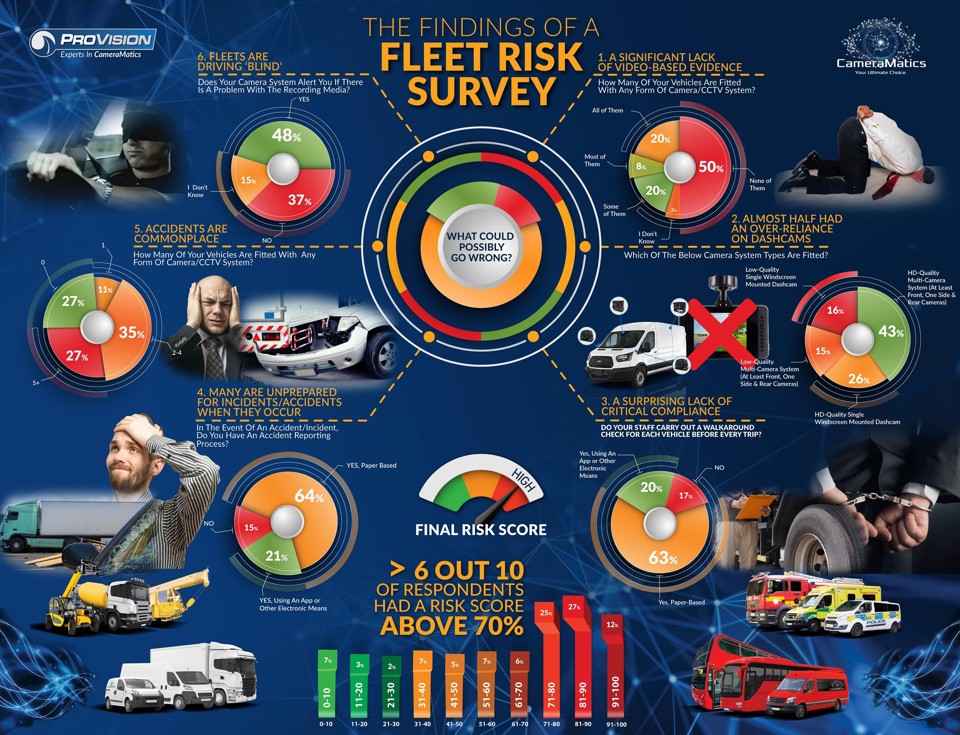Almost one in five fleets do not carry out walkaround checks on vehicles, a new survey suggests.
The study into fleet risk, conducted by ProVision CameraMatics, showed many fleets are putting themselves at undue risk by not adhering to basic compliance.
Reassuringly, almost two-thirds of respondents (63%) did say they conduct a walkaround check on paper, but ProVision said this can introduce disconnects and delays in reporting that may cause issues.
Electronic records are easier to maintain and review, it said. It means that fault reports are instantly relayed to the fleet manager, ensuring that compliance is maximised. This is especially important where a critical fault (such as issues with lights, brakes or key electrics) are reported. It also ensures that all data is saved in one place, online and accessible.
The study also highlighted the difference in responses between those who have invested in cameras for their fleet and those that haven’t when it comes to carrying out vehicle checks.
When the results were filtered to those respondents without cameras and with cameras, fleet operators that invest in cameras are more likely to insist on vehicle checks and far more likely to do so using electronic means rather than paper (41% versus 18%).
Further, filtering the data to only those respondents who invested in higher-end multiple cameras, the difference was starker, with zero respondents saying they do not carry out vehicle checks, although more do so using paper than electronic means.
The data seems to indicate a correlation between understanding risk, and so investing in risk avoidance/ management technology and following best-practice compliance. In other words, those that do the right things also buy the right things and vice versa, said ProVision.
The study also found that just 20% of fleets questioned had cameras in all vehicles and half had no cameras installed at all. Of those with cameras, 42% were relying on single windscreen-mounted dashcams, without data analysis tools or any reporting functions.
The results come from ProVision’s newly developed Fleet Risk Assessment Tool, an interactive survey tool, designed to help commercial fleet operators accurately evaluate individual business risk exposure.
The tool gives each respondent immediate personalised insights into how to improve safety and reduce risk to their fleet and provided ProVision with the anonymous data for the study.
Simon Murray, co-founder and sales and marketing director at ProVision, said: “The results show that a surprising number of fleet operators are grossly unprepared and under-protected for incidents and accidents that may occur.
“According to our findings, the majority of fleets with cameras have no mechanism to be made aware if a failure occurs in the hardware and have no access to the footage unless the vehicle returns to base and/or the media is physically removed. This is a major gap in a fleet’s risk management and could open a fleet up to a range of risk, simply because it does not have adequate reporting and monitoring technology in place.”
The survey focuses on the extent to which key technologies, including cameras, are adopted, as well as how best practice and reporting on incidents are implemented by fleets.
Data from the Fleet Risk Assessment Tool, hosted on the ProVision website, was mined from September 2017 to January 2018, with an accompanying extensive report created. This was designed to provide clarity for those reviewing and assessing safety procedures and transport policy and offer insight into the nature of risk.
The data was used to create a ‘Risk Score’ grading for those who took part based on the procedures and hardware each fleet has in place to manage risk. The results showed more than six out of 10 respondents had a risk score above 70%.
Key findings
- 17% of respondents do not carry out walkaround checks 15% admitted not having any accident reporting process
- 20% had cameras in all vehicles and 50% of respondents had no cameras installed
- 42% of those with cameras only had a single windscreen-mounted dashcam
- 52% reported that their cameras did not alert them of hardware failures
- 80% reported they did not have remote access to camera footage
Murray said: “Of all the data we extracted, the overall picture is that many fleets are opening themselves up to unnecessary risk and exposed to large claims, insurance fraud, lawsuits, high legal costs and a heavy administrative overhead while dealing with claims.”
The highlights of the findings can be viewed, and the full report, along with infographic versions of the key data, downloaded at: www.provisioncameramatics.com/fleet-risk-survey-report/.
The Fleet Risk Assessment Tool can be accessed here: https://www.provisioncameramatics.com/risk-assessment/.



















Login to comment
Comments
No comments have been made yet.